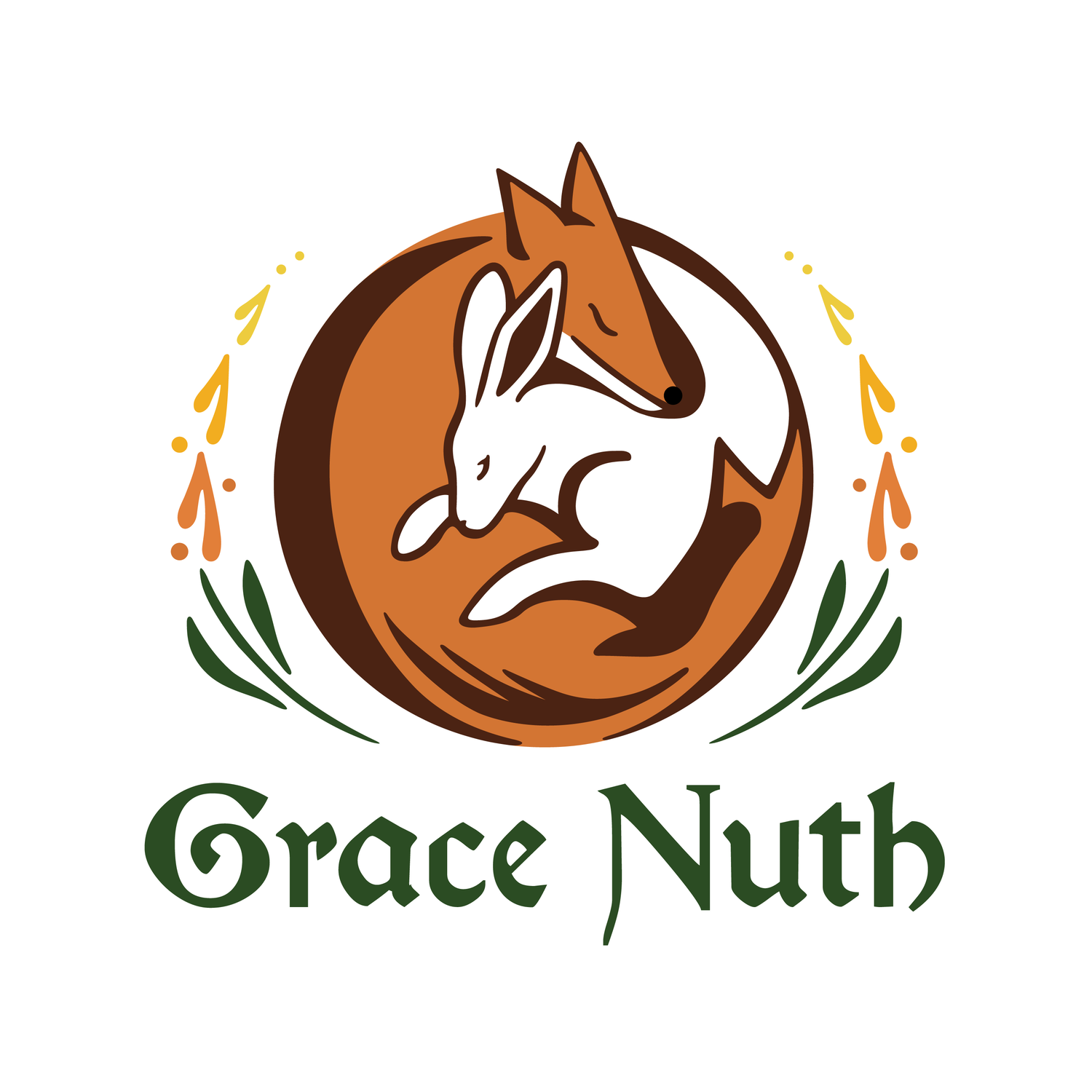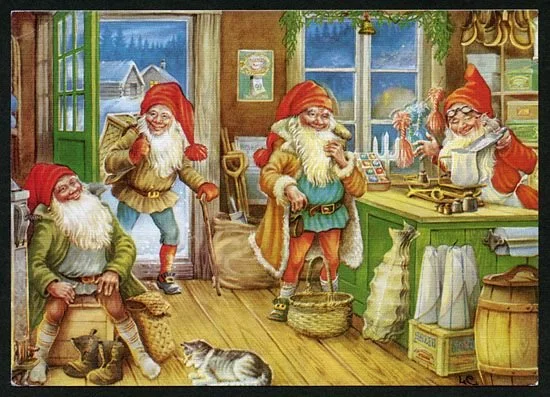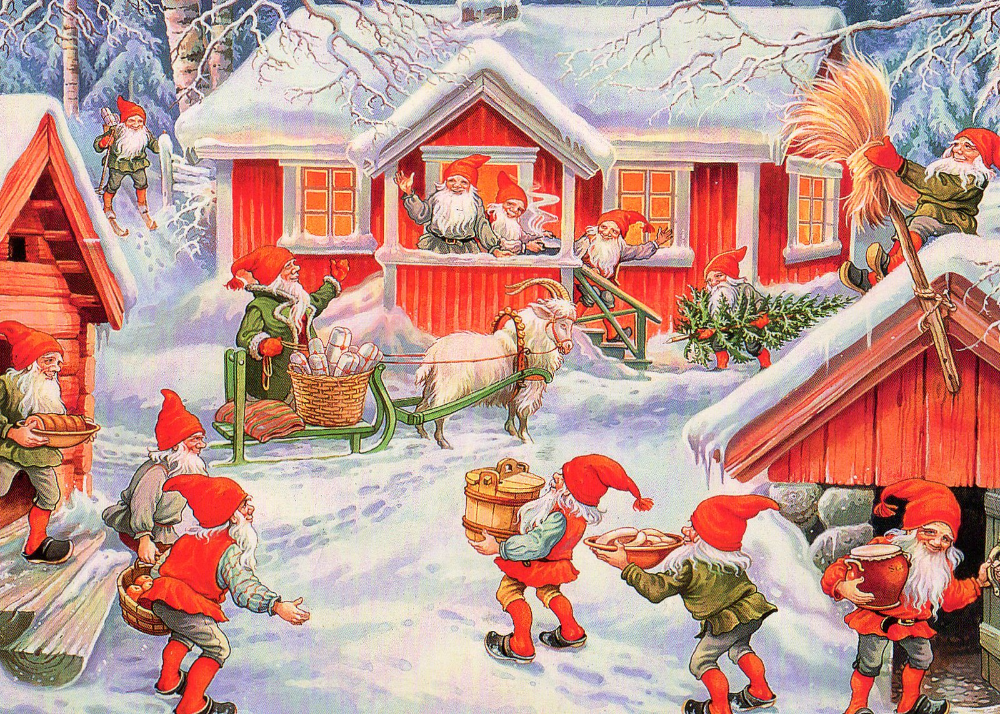Ingefær and the Tinkerers
/Thus far in my four previous stories, my friends, I have told you about how Klaus and I met, how we rescued a magical reindeer who linked us to the Faerie realm, how I gained my beloved hare familiar, and how we saved the son of the Seelie King of Faerie and gained our immortality. But you may now be counting on your fingers, recalling all you've ever heard of Santa Claus lore and realizing that there are still a few gaps in the legend.
We now have our team of eight fey reindeer steeds led by Runeolf the Red. My potions and our magic help explain much of how we accomplish what we do, and the time-shifting power of Faerie and the immortality granted to us by the King clarify the story further. But what about all the toy making elves? Oh, it makes us both chuckle each time we think of how these stories grew and warped and changed into what you know today. But like all good legends, of course there is some bit of truth to them. So let me recount the tale of how we gained that particular aforementioned thread of the fable.
The social structures, hierarchies, and existing types of fae folk are topics so broad, they could fill whole volumes of books. Indeed, they already have. As Klaus and I grew further enmeshed in the Faerie lands, we learned very quickly (and sometimes painfully) which of the stories we had grown up hearing from our elders were factual, and which were keenly, sorely incorrect.
Let me tell you a few facts about the fey beings you know as gnomes. There are three sub-classes of gnomekind; barn gnomes, (known in Norway as nisse) garden gnomes (some of whom can also be found in the forest), and tinkering gnomes. All three classes of gnomes are considered to be valuable assets in Faerie society. Nisse are wonderful liasons and ambassadors to the human world, and help lull humans into a false sense of security about how “safe” the world of the fey can be, what with all of those innocuous stuffed icons of their kind mortals place about as decorations at Christmastime. Garden gnomes of course help to make the realms even more beautiful, and are incomparable at food production. Most of them are rather good humored about the depictions humans place in their gardens of their diminutive selves. A few do tend to get a little grumpy about it; their faces get so red with fury they match their cunning pointy caps.
That is all I’ll say about the first two categories of gnomes, because our tale today mostly concerns the third type: the tinkerers. These gnomes use a fascinating blend of magic, technology, a little alchemy, and the Faerie lands’ version of science to make absolute miracles in building, mechanics, and other necessities.
Theirs is, like most fey types, a monarchical society led by a king or queen. The ruler of the gnomes is almost always chosen from among the Tinkerer class, as they are deemed the wisest (and are certainly the richest) of the three.
In the human year of 1814, His Majesty King Urwin ruled the gnomeish folk. Because of our fame among the fey after High King Fionn’s gifts five human months before, we were granted access to many of the lower courts of Faerie and found ourselves invited to many gatherings and balls. Urwin, with his jovial smile and his fascination with all things mechanical, was a natural kindred spirit for Klaus.
Urwin had six children, five grown with their own households. The youngest was Princess Elianiffi, known as Fee among her family and friends. Little Fee was fascinated with Klaus, who looked so much like her father with his long white beard and sparkling eyes, but was approximately twice as big.
“Tell me the story of Runeolf?” “Can I hear the story of the first time you delivered gifts to the children of northern Norway?” she would ask Klaus when her family would visit our little cottage. And the whole family, Urwin, his wife Aska, and of course Fee would stop and listen to the story. This is something else you should know about tinker gnomes: they love a good tale, and have a great respect for the natural curiosity and open-mindedness of children. After all, it takes a great deal of imagination to create the way they do. No gnome child (and there are many…unlike the high fey, they are prolific family makers) is ever told to hush or stop asking questions. The adults are always open to listening, in case they learn something new through the words or curiosity of a child.
Our two families grew closer and closer, until it wasn’t uncommon to see little Fee’s head bobbing beside Klaus’s as he stacked firewood, or bent over a woodworking project in the toy workshop. And indeed, Klaus found her to be a wonderful helper, with questions that made him consider new ways of doing his yearly work to make toys.
Soon when Fee would visit, she would bring friends with her. Urwin explained at our next dinner that Fee loved returning to their great hall and telling everyone all about what she was learning and seeing. In fact, a few adult tinker gnomes started to show up soon thereafter on our doorstep, magnification goggles in hand, carting along their wheeled and hovering boxes of supplies.
“Do you mind their help?” asked Urwin apprehensively. He knew Klaus loved the work of making gifts for the children from the villages.
Klaus responded with his signature booming laugh. “Mind? My dear friend, this only means that I can give gifts to even more little children than ever before! I only hope you don’t mind that we are but poor folk who cannot pay your usual rate for such incredible services.”
Urwin nodded slowly. “That is admittedly an issue,” he acknowledged. “Unlike our barn gnome kin who only ask for a bowl of Risgrøt on Yule, we tinkerer gnomes are used to being paid for our services, and paid well. For the continued kinship between us, I would like to find a way to be fair to us both. My people do deserve to see recompense for their work.”
Klaus and I both nodded emphatically. Already the gnomes had set about working to expand Klaus’s workshop into a footprint three times its size, making space for new mechanical toy-production contraptions. No one had negotiated payment, they were all too absorbed in trying to figure out how to invent new things to solve existing challenges they’d never encountered before. Nothing brings a tinkerer gnome more joy than this…a heretofore unseen puzzle. But a need for recompense would come, and we could see the costs rising with every new brass and copper pipe and welded mechanism.
When Klaus walked out one morning to feed the chickens and goats and check on the reindeer, he found the work had already been done for him. From the corner of his eye, he saw the tip of a pointed red hat slip down to hide behind a stall door. Apparently we now also had a barn gnome. I would have to remember to set out some rice porridge with butter on Christmas Eve before helping Santa pack his sleigh.
We all knew we had passed the point of no return when three of the gnomes approached us about building sleeping chambers for some of the folk. Certain projects had to be continually monitored, and those working on them were practically asleep on their feet when they trekked halfway home. Some even brought pillows back with them and were sleeping under the tables while their experiments bubbled or cranked away. Our little home was turning into a campus, and though we appreciated the assistance with all our hearts, we knew that the “free” labor would tilt the axis of the gnomeish economy if something wasn’t done soon.
The three gnomes who asked about building sleeping quarters nodded sheepishly when they saw our slightly shell shocked expressions, and I gently told them that we would have to think about things a bit. That night, Klaus and I conferred together until we were too exhausted and fell asleep. But no answer was apparent. We simply didn’t have the sort of wealth to afford the work that the gnomes were offering us, as marvelous and miraculous as it was.
In times of turmoil, and moments when I need to re-center myself, I go to the spring where I drew the water to first make my Northern Lights potion. The spring has a small shrine built of stones, and the shrine backs into a mountain ridge. Many years ago, as a small child, I had discovered a cave not far from the shrine. When I needed to go inward, or to pray, I would sometimes go there. Deep in the quiet of the cave, far from the tap of hammers and scrape of metal, I felt myself begin to breathe more deeply.
“My Lady Earth,” I whispered, running my hands along the rock walls, “Great forest, running water, aurora and stars in the sky. What do we do? We’ve been given so many wonderful gifts by the faeries, but all things have a price, and we can only offer our gratitude, and what magics we have learned and been granted. We feel called to this great work, to bring joy and hope to children all over the world. And the gnome folk understand the importance of little ones, of minds not yet closed to the wonders and possibilities of the world. But they also should be fairly compensated. And we can’t think of anything in our power.”
Bending slowly to my knees, (I wasn’t as lithe as I had been, immortality or no) I continued to run a hand along the wall, gaining strength and grounding from the solid rock under my touch. I tried to empty my mind of all but the sensations in the moment. And that was when I felt it.
A section of the rock I was tracing felt significantly warmer than the rest of the cool surface. With eyes still closed, I tracked the warmth as far forward as my reach could go. Stooping to stand, I bent over and continued to trace the warm stone. In the lantern light, I could distinguish no difference between the warm and cool stone. There was no magical glow or tracery of a different shade of rock. But still I followed the guide of my hand, until the heat beneath my hand gave way to empty air. There was an opening in the cave wall. I had never noticed it before because it was so low to the ground, and so small. A human, even a child, could never fit in so small a space. But a gnome…
Fee was the smallest of the gnome folk, and she followed Klaus and I excitedly to the cave to see what was in the hidden cavern. As it happened, we had sent word to her father the night before to join us that evening to discuss the gnome helpers. Loathe as we were to do so, we planned to tell him we would have to cease the operations, due to a complete lack of funds to fairly pay. Urwin was always an early arrival to gatherings, and he ran with us to the cave along with several other curious folk. When we arrived at the tiny crevasse in the wall, Fee looked at her father questioningly.
“Be careful, dearheart, but be brave. Here, take this,” he told her, and gave her a small gnome-sized lantern that, when he blew on it, glowed ten times brighter than the candle in my larger lamp. Gnomeish inventions never ceased to awe me.
It wasn’t long before we heard the echo of her cry from the other side of the small opening.
“Fee??” I called, worried sick.
“It’s ok! I’m ok! The skeleton just scared me.”
Urwin and Klaus exchanged glances.
“Ah, Fee? Maybe it’s time to come back, love,” her father called.
“Coming, da, just one moment!”
Fee re-emerged, covered in a fine layer of dirt and dust. Her skirts were bundled high above her knees, and her white teeth shone in the lamplight.
“Da, look at this!” she cried, and let go of her skirts. Faceted jewels, gold nuggets, and silver coins spilled to the floor.
Faerie dragons, you see, are not the large monsters of human myth and legend. Urwin explained this to us later. They are quite small, but also exceedingly strong. Strong enough to pull whole hoards of treasure into their hidden caves, only accessible through small fissures.
And years, sometimes centuries, after a dragon has died, certain ores in the stones still retain the warmth of its breath.
The treasures were ours, Urwin insisted. Even though only a gnome could reach the hidden chamber, the cave was located firmly within the borders of our land. When we returned to our home, the king gathered those of his people who were helping us, now thirty-some strong, and told them of our discovery, declaring it a sign that we were meant to formalize and continue our collaboration.
I whispered a small thank you to the Earth Mother for her guidance. I agreed it was a sign, and her blessing would be cherished.
And so, my darlings, we did. Over years of work, the Klaus residence turned into the incredible complex now known to many of you as the “North Pole,” though it is nowhere near so geographically. Oh, and shortly after we discovered the secret hoard, when Klaus and I were both giddy with joy at knowing we could expand and explore so many possibilities with our mission, he was sitting near one of the gnomes as they explained to him a new invention.
“Ho ho ho! You all are just such incredibly efficient little fellows!” he declaimed loudly. The gnomes found the description delightful, and started to use it among themselves. Before we knew it, one of them had made badges with “efficient little fellows” written in tiny script. And then, of course, because gnomes also love a good pun and wonderful irony, one of them suggested they use ELF for short. Oh, the laughter that ensued, since tiny gnomes are about as far off visually from the tall ethereal elves as could possibly be. But the name stuck, and thus you see why Santa being called a jolly old elf is so humorous to them. Because in their hearts, and in ours, we truly were gnome-kind, just exceedingly tall.
Oh and little Fee? Of course eventually she grew up. And became the head elf. And our beloved god-daughter.
And that is the story of how Santa Claus got his elves.
All art by Lars Carlsson







